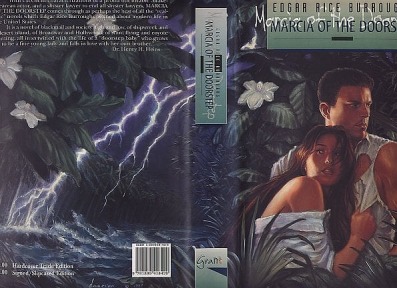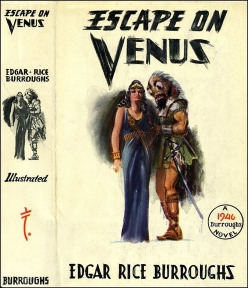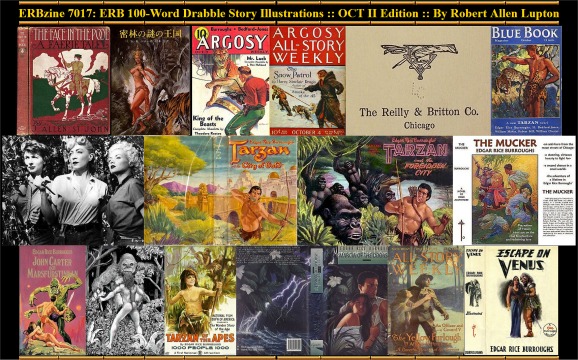
Official Edgar Rice Burroughs Tribute and Weekly Webzine Site Since 1996 ~ Over 15,000 Webpages in Archive Volume 7017 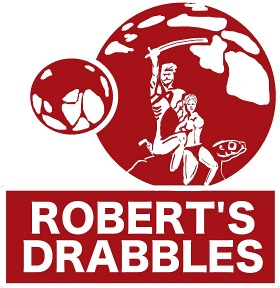 |
ERB 100-Word Drabbles
OCTOBER II Edition :: Days 1-15
See Days 16-31 at ERBzine 7017a
by Robert Allen Lupton
With Collations, Web Page Layout and ERBzine References by Bill Hillman
I KNOW HOW TO DRAW
October 1, 1972: J. Allen St. John was born in Chicago on this day. The earliest record of his relationship with A. C. McClurg was the publication of his novel, “The Face in the Pool.” He wrote and illustrated the book. The art from that book is featured in ERBzine 2305.
James Allen St John was the son of Josephus Allen St. John and the former Susan Hely - the daughter of Hilliard and Mary (Vowell) Hely of Johnstown, Ireland. The Helys were both excellent artists. According to the St. John, "My first recollections are of my mother's art studio and the magic way the eyes of her portraits followed me as I walked about the place."
Speaking only for myself, the J. Allen St. John illustrations made me appreciate the novels all the more.
“I Know How To Draw” is today’s Edgar Rice Burroughs inspired drabble.
She said, “I didn’t expect any men in this class.”
“I’m a writer and I hope typing will be faster than a fountain pen. Corrections will certainly be easier.”
“Are you a journalist?”
“No, I’m a storyteller. Here’s my first book, “Face in the Pool.”
“Really! I love the cover.”
“I drew the artwork myself."
“You’re quite the talent. You should be in art school, not here.”
“This is where I belong. I can’t type and I already know how to draw.”
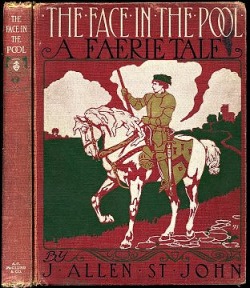
FREEDOM TO CHOOSE
October 2, 1929: On this day Edgar Rice Burroughs began writing “The Dancing Girl of the Leper King.” The story was originally serialized by Blue Book Magazine from May 1931 through September 1931 under the title, “The Land of Hidden Men.”
The first Blue Book Magazine cover was by Laurence Herndon. Edgar Rice Burroughs Inc. published the first edition in 1932 with the title, “Jungle Girl.” Ace books used the Blue Book title, “The Land of Hidden Men” and released the first paperback edition in 1963 with Roy Krenkel Jr. cover art.
Featured here is the Japanese cover art from
The Japanese cover art by Motoichiro Takebe is used with this post.
“Freedom To Choose” is today’s Edgar Rice Burroughs inspired drabble.
Charles King saved Fou-Tan from a panther, she said, “Beauty is a curse. I escaped an evil old man and then was forced into semi-slavery as a dancing girl for the Leper King. The king desired me and I fled.”
“In my country, many women try to attract a king’s love.”
“I choose who I love and won’t have love forced on me by some diseased man claiming godhood and be cast aside, given to another, or murdered when he tires of me.”
“In my country lawyers protect the rights of women.”
“And in country, warriors kill all the lawyers.”
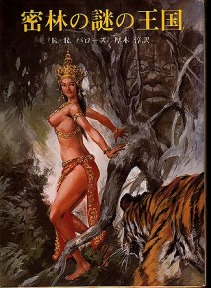
NOTHING UP MY SLEEVE
October 3, 1936:Argosy Weekly published part three of “Tarzan and the Magic Men” (Tarzan the Magnificent) on this date. The cover art by V. E. Pyles illustrated the novelette, “King of the Beasts” by Theodore Roscoe. The issue also contained part two of “Raid of the China Clipper” by H. Bedford Jones, “A Gent from the Pecos” by Robert E. Howard, and “Mr. Luck” by L. Ron Hubbard. Pretty strong lineup.
“Nothing Up My Sleeve” is today’s Edgar Rice Burroughs inspired drabble.
Stanley Wood and Tarzan fled from Queen Gonfala of Kaji, but Mafka, her magician, used his powers to order them to return, but Tarzan ignored the summons.
Wood asked, “How can you resist him? All I can think of is to obey his commands.”
Tarzan shrugged. “He’s not my first witch doctor. Belief is a powerful thing. You believe he can control you and I believe he can’t control me. We’re both right.”
“I’ve seen his powers. He’s truly magic.”
“Everything you don’t understand is magic. Once you peek behind the curtain, you’ll find he’s the same as everyone else.
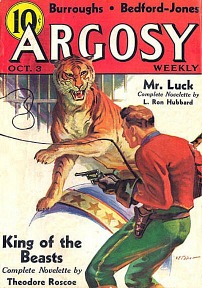
HEAD COW IN CHARGE
October 4,1924: On this day Argosy All-Story Weekly published part four of “The Bandit of Hell’s Bend.” The cover by Norman Price illustrates part one of “The Snow Patrol” by Harry Sinclair Drago. A woman in a mink coat is whipping a man helping the sled dogs pull the sleigh through deep snow. The issue also included part two of Max Brand’s “Clovelly.” “Bandit Of Hell’s Bend” is, in my opinion, one of the best book titles – ever.
“Head Cow in Charge” is today’s Edgar Rice Burroughs inspired drabble.
Texas Pete said, “I’m from Princeton, but Princeton Pete
sounded stupid.”
Idaho said, “Real name’s none of your bidness. Idaho
sounds mysterious like.”
Shorty said, “I’m called shorty ‘cause I’m so tall. Bull,
how’d you get your name?”
“The bull is always in charge. He’s the boss and he gets
the women.”
“Don’t give yourself airs. I’ve seen you ride and you’re
one bad bounce on a saddle horn from being a steer.”
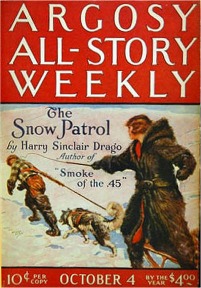
SIMULTANEOUS SUBMISSIONS
October 5, 1912: On this day Edgar Rice Burroughs wanted to find another market for “Tarzan of the Apes” and he submitted it to A.C. McClurg and Company, hoping for book publication. McClurg turned it down.
(This day in 2019 was a busy day for the Luptons as it was the first day of the 48th Albuquerque International Balloon Fiesta)
Undaunted, he tried Bobbs-Merrill Co., Reilly & Britton, and then Dodd, Mead and Co. Meanwhile, the Evening World Daily Magazine did publish it, but that didn't convince Rand McNally that the story would sell as a book, because that company turned it down, too.
Reilly and Britton and Bobbs-Merrill published Oz books and other books by L. Frank Baum. The crossovers would have been amazing. Tarzan and the Cowardly Lion, Woola Meets The Hungry Tiger, and of course, Dorothy and Dejah Thoris in the Deadly Desert.
Then, on May 1, 1914, ERB was surprised to hear from McClurg again. After thinking it over, McClurg decided they’d take a chance on the book. Burroughs agreed to sell them the first book publication rights and the book was published that June.
The Reilly and Britton Co. logo is the photo with today’s post.
The Edgar Rice Burroughs inspired drabble today is “Simultaneous Submissions.”
“Yes, Emma, they do. But if all four reject the story, it doesn’t matter. If only one accepts the story, it doesn’t matter. It only matters if two or more of them want to buy it.”
“What happens then?”
“I’ll sell it to the one who offers the most money. Publishers
only say they don’t accept simultaneous submissions because they don’t
want to bid against each other.”
“But the one who doesn’t get the book will be mad.”
“I only need one publisher.”
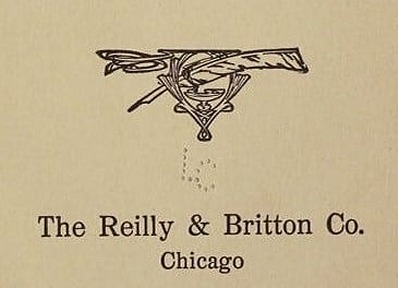
I FIGHT FOR MYSELF
October 6, 1952: On this day, Whitman released abridged versions of “Tarzan and the City of Gold” and “Tarzan and the Forbidden City.” Whitman was the primary publisher of Big Little Books and published several Tarzan titles. The front and rear cover of City of Gold was drawn by Don McLoughlin and Jesse Marsh drew the endpapers and twelve interior illustrations. Forbidden City’s cover was also drawn by Don McLoughlin and the seventeen interiors and endpapers by Jesse Marsh.
The Edgar Rice Burroughs inspired drabble today features a strong willed, independent,
and jungle-savvy Jane, for no other reason than I liked it. “I Fight For Myself” is today’s drabble.
The chieftain said, “Little girl, you shouldn’t be alone in jungle.”
“You find a little girl out here, spank her butt and send her home. Help me bury these idiots.”
“What happened?”
“I killed them is what happened.”
“By yourself? Where your men?”
“My man is busy elsewhere. I fight for myself. I don’t need men. Help me bury them.”
“I see. This is woman’s work. Bury them yourself.”
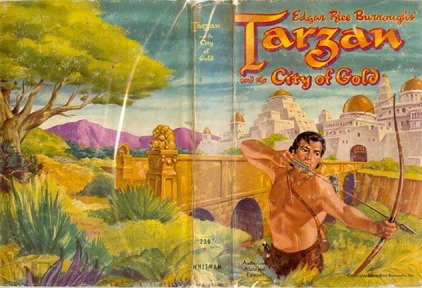
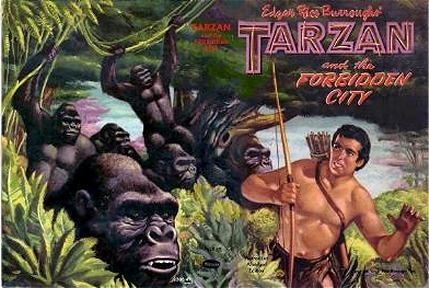
A PELLET A DAY
October 7, 1935: Part one of “Tarzan and the Immortal Men” (Tarzan’s Quest) hit the stands. The Blue Book issue was dated October, 1935. The blonde Tarzan on the cover was drawn by Herbert Morton Stoops and interior illustrations were by Frank Hoban. This issue also contained the final installment of “Hawk of the Wilderness” by William L. Chester and “Arms and Men: IX – by H. Bedford Jones along with more than a dozen other stories.
Today’s Edgar Rice Burroughs inspired drabble is “A Pellet a Day.”
“That’s what the witch doctor claims. The ingredients are disgusting, but no harm in trying.”
“You sound skeptical, but you gave them to Nkima and Jad-bal-ja.”
“Yes, I am skeptical. Too good to be true is too good to be true. Muviro told me about a white hunter who asked Muviro why he was smart. Muviro said, “I take smart pills,” and sold several pills to the hunter.
The hunter said, “These taste like rat crap.”
Muviro said, “They are rat crap. See, you’re getting
smarter already.”
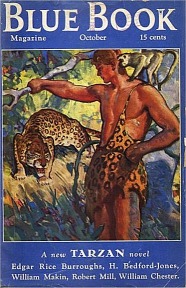
WIN OR LOSE
October 8, 1926: Jil Jarmyn was born in Batavia, Illinois, USA as Donna Joyce Sellers. She is an actress, known for Swamp Women, with Mike Connors,(1956), No Man's Woman (1955) and War Drums (1957). She was the last of 3000 woman eliminated in Sol Lessor’s national search for a new Jane to play opposite Gordon Scott in Tarzan’s Fight for Life. Eve Brent got the part.
Later, she became notorious for an incident in her private life when she filed assault charges against Susan Hayward after she and the star went at it claw to claw in the bedroom of her former fiance, Don 'Red' Barry. Jil got the worst of it, but under pressure from Hayward's studio, she reluctantly dropped the charges.
Featured here is the publicity photo from “Swamp Women." From left to right: Jil Jarmyn, Marie Windsor, and Carole Mathews.
“Win or Lose” is today’s Edgar Rice Burroughs inspired drabble.
“Thanks, but out of 3000 women, I was the last girl eliminated.”
“Yes, you were the first runner up.”
“That’s not how I see it. Back home in Illinois, we call the person who finishes second the same thing we call the person who finishes last.”
“What’s that?”
“Loser!”
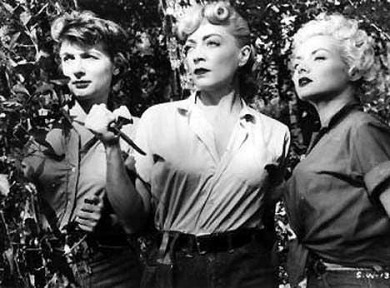
SOULLESS
October 9, 1913: Edgar Rice Burroughs finished writing “The Mucker.” He submitted the story to All-Story, New Story, and Adventure. All three magazines passed. Ed revised the story and resubmitted it to All-Story. Metcalf, the editor bought “The Mucker,” paying $1,450 for the story and it was published by All-Story Cavalier Weekly in October of 1914. The story was published in England as “The Man Without a Soul.”
The illustration attached is from a variant dust jacket designed by Charles Madison on his website, www.erbgraphics.com. “This dust jacket is built around a Vaclav Cutta illustration that was done in 1927 for a paperback edition printed by the Sotec Publishing company in Czechoslavakia." Charles does good work.
“Soulless” is today’s Edgar Rice Burroughs inspired drabble.
Metcalf said, “People want to read about heroes overcoming impossible odds and riding off into the sunset with the beautiful heroine.”
Ed said, “Thomas, I don’t write fairy tales.”
“Fine, but I can’t sell stories about bad men seeking
semi-redemption. Good guys win, and bad guys lose. In America, we want
our bad guys dead at the end of the story.”
“I can rewrite it and make Billy a better person.”
“Good plan. No one wants a story about a man without
a soul.”
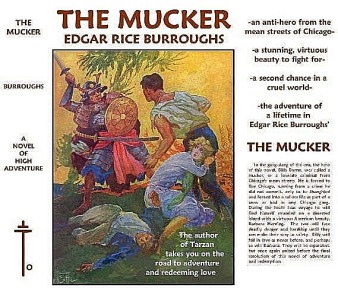
HOPE SPRINGS ETERNAL
October 10, 1917: A. C. McClurg published the first edition of “A Princess of Mars.” The 326 page book had a dust jacket by Frank Schoonover and five interior sepia plates.
The print run was 10,200. Grosset and Dunlap published numerous reprints from 1918 to 1940. I have 18 G and D variants in my collection. ERB Inc. reprinted the novel in 1948. Countless editions - authorized and unauthorized - foreign and domestic, exist. Someone somewhere is probably putting a new edition right now.
The illustration is from a 1975 Swedish edition of the book.
“Hope Springs Eternal” is today’ Edgar Rice Burroughs inspired drabble.
Woola whined and snuggled closer. She continued, “He was a wonderful man. I hope he’ll survive and come back to me. Oh, Woola. Do you think he’s alive?”
Woola looked at a bright blue star. He barked twice, wagged his tail, and licked her face.
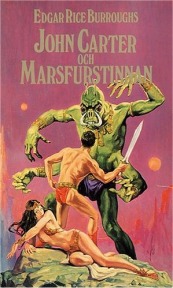
KEEP YOUR HEAD
October 11, 1952: Shaun Raymond Hoadley was born in Kalamazo, Michigan. An artist he had pieces published in Fanzines as well as professional publications, advertising and more. Hoadley is not as well-known as many other ERB artists, but he has a considerable body of work.
Jerry Schneider of ERBVille Press commissioned him to work on many of the ERB Uniform Limited Edition Hardcover Series editions: The Man-Eater (4 black & white interior illustrations, 1 color frontispiece/DJ), The Cave Girl (4 b/w interiors), The Cave Man (4 b/w interiors), "Lost Inside the Earth" (magazine version of At the Earth's core) (cover/frontispiece), The Mad King (4 b/w interiors), Barney Custer of Beatrice (4 b/w interiors), The Rider (4 b/w interiors), The Oakdale Affair (cover/frontispiece and 4 b/w interiors).
Several portfolios of his work can be reviewed at www.erbzine.com/mag8/0842.html.
Today’s drabble has nothing to do with Mr. Hoadley’s work, but I like “The Chessmen of Mars.” I’ve had this one written for a while and wanted to use it.
![]()
Today’s drabble is “Keep Your Head.”
Gahan quickly threw his dagger into Luud’s face. The kaldane rolled on the floor. Gahan kicked the creature, who was almost all head into the wall.
Ghek boarded the headless rykor and took control of the magnificent mount. “King Luud is dead. You’ve killed him.”
“Yes,” said Gahan. “It had to be done. Sad, but he’s not the first man to lose his head over a woman.”
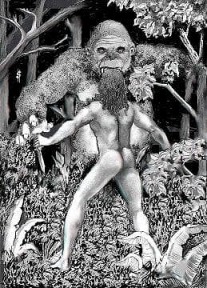
LIKE FATHER, LIKE SON
October 12, 1958: Gordon Griffith, who played young Tarzan in the first movie, died in Los Angeles, California. Griffith is one of three candidates for the title of "first Tarzan," since he played the part of young Tarzan in the first Tarzan movie, “Tarzan of the Apes.” (The other candidates are Elmo Lincoln, the front-runner, and Stellan Windrow. Griffith also played in “The Romance of Tarzan,” “The Adventures of Tarzan” and “The Son of Tarzan.”
He was active in the film industry for almost fifty years, appeared in over 60 films, worked as an assistant director, and produced films. He worked with Charlie Chaplin, Mary Pickford, and played Tom Sawyer in “Huckleberry Finn.” He appeared in several of the Little Billy films before he played Tarzan and later Korak. To my knowledge, he is the only actor to play both Tarzan and Tarzan’s son, Korak, on the big screen.
“Like Father, Like Son” is today’s Edgar Rice Burroughs inspired drabble.
“No worries. My parents were both actors. I’ve played boys, girls, monkeys, and even one of Little Bo-Peep’s sheep on stage.”
“I’m not sure that the audience will accept you as Korak?”
“They will. I’ll change my hair, smear some mud on my face, and walk differently. I’ll believe that I’m Korak and so will the audience. If you want, I’ll play the young Lord John Greystoke, Tarzan’s father. That way, I’ll have played three generations and I’ll be my own grandpa.”
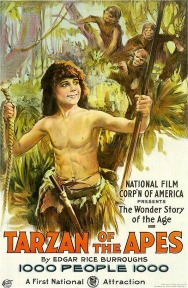
IT'S ABOUT TIME
October 13, 1924: Edgar Rice Burroughs completed his longest novel, “Marcia of the Doorstep.” The book ran 125,000 words and was submitted frequently, but unsuccessfully during his lifetime. The book was published by Donald M. Grant in 1999. There was a trade edition and a signed limited edition in slipcase limited to 750 copies. The magnificent cover is by Ned Dameron. The deluxe edition is signed by Danton Burroughs, Henry H. Heins, and Dameron. The official ERB stamp is on the signature page.
For more information on the book, visit www.erbzine.com/mag7/0772.html
Today’s Edgar Rice Burroughs inspired drabble is excerpted from
Danton Burroughs’ foreword to the book. Let’s call it “It’s About Time.”
We are presenting MARCIA OF THE DOORSTEP here just as Ed wrote it in 1924. We have maintained his original style of punctuation even though the modern reader might be more used to a simpler more direct style of sentence construction. Likewise we have maintained some racial references as they are used by villains and further show their negative qualities, or by characters referring to themselves or their kind in a manner common throughout most of this century. I trust that none of you will be offended by our maintaining of this authenticity.
KITTY'S LAMENT
October 14, 1916: All-Story Weekly published the conclusion, part four of “The Girl From Farris’s.” The magazine’s cover illustration was for “The Yellow Furlough” by Alfred D. Petibone, a powerful drama of the Service – An officer and a coward?”
The issue contained stories by Horatio Winslow, Margret Parker Hays, and Sir Charles George Douglas Roberts. Winslow wrote dozens of stories for the pulps and was a frequent contributor to the Saturday Evening Post. Margret Hays wrote over 100 stories for All- Story Weekly between 1915 and 1924. Her best known work is “Vegetable Verselets for Humorous Vegetarians.” Roberts, a Canadian, wrote poetry, short stories, and novels. His animal stories, frequently about dogs, were very well received. He was called the “Father of Canadian Poetry.” On June 3, 1935, Roberts was one of three Canadians on King George V's honour list to receive a knighthood. Pretty good company for a little girl running away from Chicago.
“Kitty’s Lament” is today’s Edgar Rice Burroughs inspired drabble,
with a nod of appreciation to songwriter, Norma Jean Beasler, and singer, Kitty Wells.
“Don’t matter. I saw what I saw.”
“I doubt you were on a mission from God. How old were
you when you decided to sell yourself.”
“There’s not a woman there because of God’s will. Every woman in that place is there because of some man, a man who treated her badly, beat her, threw her out, or turned her out. Every married man who thinks he’s still single pushes some woman toward the wild side of life.”
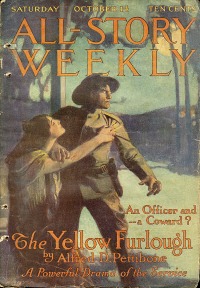
October 15, 1946: Edgar Rice Burroughs Inc. published the first edition of "Escape on Venus,” with a cover and interior illustrations by John Coleman Burroughs. The print run was 20,000 copies. The novel was published in four parts in Fantastic Adventures in 1941 and 1942. “Slaves of the Fish Men” appeared in March of 1941, “Goddess of Fire” in July 1941, “The Living Dead” in November 1941, and the conclusion, “War on Venus” in March 1942. The last three segments were reprinted in issues of Fantastic Adventures Quarterly. The St. John nude painting that appeared with “Goddess of Fire” was repainted by H. W. McCauley and she was clothed in a flimsy negligee.
There are differences between the original magazine version and the book version. There are even two different book versions. The hardback version appeared in ERB Inc.'s first edition, and all subsequent hardback editions followed that version. Paperback editions were based on the original magazine version.
Since Fantastic Adventures was a monthly and it is difficult to assign a publication date, I want to mention that Ralph Milne Farley’s story, “City of Lost Souls,” was also in the March, 1946 Fantastic Adventures. Farley wrote the story with Al. P. Nelson and the duo used the pen name, Don Warren. Farley is the author of the Radio Man series. They’re well worth reading.
“Sharp as a Woman’s Glance” is today’s Edgar Rice Burroughs inspired drabble.
After escaping the Fish Men, Carson and Duare relaxed in a beautiful idyllic valley. Carson asked Duare to marry him. “We can live here.”
“I’m a princess. I must return to Vepaja and marry a noble
when I’m twenty and have children before I become queen.”
“But I love you.”
“If we were in my country a man like you would be beheaded for daring to speak to me.”
“I’m not surprised. I should be used to it by now. In the land I come from I spoke to many a beautiful woman who turned away and cut me dead.”
See Days 16-31 at ERBzine 7017a
